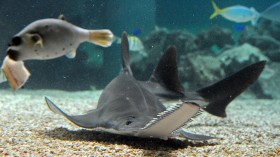Light is often understood in the context of a wave, traveling in a straight line. However, there are conditions in which light can actually act like a liquid with a continuous flow around objects - like a river turning in bends and breaks of the bank. This strange behavior of light occurs when photons forming the light wave interact with each other, according to an official statement.
Researchers from the CNR NANOTEC of Lecce in Italy and Polytechnique Montreal in Canada went one step further and turned light superfluid, which is connected to the ability of all particles to condense in Bose-Einstein condensate (also known as the fifth state of matter). In this state, particles acts like a single macroscopic wave.
"Superfluidity is an impressive effect, normally observed only at temperatures close to absolute zero (-273 degrees Celsius), such as in liquid Helium and ultracold atomic gasses," lead researcher Daniele Sanvitto explained. "The extraordinary observation in our work is that we have demonstrated that superfluidity can also occur at room-temperature, under ambient conditions, using light-matter particles called polaritons."
Fellow team member Stéphane Kéna-Cohen said that the group was able to achieve this by placing an ultrathin film of organic molecules in between two highly reflective mirrors. Light bounces back and forth between the two mirrors, forming the hybrid light-matter fluid.
"In this way, we can combine the properties of photons such as their light effective mass and fast velocity, with strong interactions due to the electrons within the molecules," Cohen said. "Under normal conditions, a fluid ripples and whirls around anything that interferes with its flow. In a superfluid, this turbulence is suppressed around obstacles, causing the flow to continue on its way unaltered."
This breakthrough could be play a significant role in the further understanding of Bose-Einstein condensates. It could also be an important part in the eventual design of photonic devices.
The study was published in the journal Nature Physics.
© 2024 NatureWorldNews.com All rights reserved. Do not reproduce without permission.
![Severe Thunderstorm Alert: Tornadoes, Damaging Winds and Hail Possible from Upper Ohio Valley to Northeast US [NWS]](https://1471793142.rsc.cdn77.org/data/thumbs/full/70161/280/157/50/40/severe-thunderstorm-alert-tornadoes-damaging-winds-and-hail-possible-from-upper-ohio-valley-to-northeast-us-nws.jpg)




